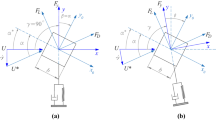Abstract
Galloping is the low-frequency, self-excited oscillation of an elastic structure in a wind field. Its analysis is commonly based on a quasi-steady aerodynamic analysis, in which the instantaneous wind forces are derived from force data obtained in static wind tunnel tests. For the galloping of a rigid prismatic beam the validity of the quasi-steady assumption is critically assessed for the case that rotational effects must be included in the aerodynamics. An oscillator structure with one (torsional) degree of freedom is proposed which allows a reliable modelling. Its effective motion can be considered as being composed of a translation with a coupled rotation of the cross section, and can be regarded as a natural extension of pure translational galloping. The analysis reveals that the resulting aerodynamic damping is determined by the sectional aerodynamic normal force coefficient alone. An aerodynamic damping coefficient is defined that can be expressed uniquely in terms of an aerodynamic amplitude, allowing a normalization of the galloping curve. This result can be used to analyze both purely translational and combined galloping, which are found to differ only by the way the structural amplitude (displacement) is related to the aerodynamic amplitude. An interesting result is that for large wind speeds rotational galloping displays an aerodynamic limit, in contrast to translation galloping where the limit-cycle amplitude increases linearly with wind speed. Results obtained from wind tunnel experiments confirm the major findings of the analysis.
Similar content being viewed by others
References
Bisplinghoff, R. L. and Ashley, H., Principles of Aeroelasticity, John Wiley, New York, 1962.
Blevins, R. D., Flow-Induced Vibrations, 2nd ed., Van Nostrand Rheinhold Company, New York, 1991.
Blevins, R. D. and Iwan, W. D., ‘The galloping response of a two-degree-of-freedom system’, J. Appl. Mech. 4, 1974, 1113–1118.
Dowell, E. H., Curtiss, H. C., Scanlan, R. H., and Sisto, F., A Modern Course in Elasticity, 2nd ed., Kluwer Academic Publishers, Dordrecht, 1989.
Modi, V. J. and Slater, J. E., ‘Unsteady aerodynamics and vortex induced aeroelastic instability’, J. Wind Eng. & Ind. Aer. 116, 1969, 1869–1874.
Modi, V. J. and Slater, J. E., ‘Quasi-steady analysis of torsional aeroelastic oscillators’, in Flow-Induced Structural Vibrations, Proc. IUTAM-IAHR Symposium, Karlsruhe, 1972, E., Naudascher (ed.), Springer-Verlag, Berlin, 1974, pp. 355–372.
Nakamura, Y. and Mizota, T., ‘Torsional flutter of rectangular prisms’, J. Eng. Mech. Div., ASCE 101, EM2, 1975, 125–142.
Novak, M., ‘Galloping and vortex induced oscillations of structures’, in Proc. 3rd Int. Conf. on Wind Effects on Buildings and Structures, Tokyo, 1971, pp. 799–809.
Parkinson, G. V. and Smith, J. D., ‘The square prism as an aeroelastic nonlinear oscillator’, Quart. J. Mech. & Appl. Math. 17, 1964, 225–239.
Parksinon, G. V., ‘Phenomenon and modelling of flow-induced vibrations of bluff bodies’, Prog. Aerospace Sci. 26, 1989, 169–224.
Sisto, F., ‘Stall-flutter in cascades’, J. Aeron. Sci. 20, 1953, 598–604.
Theodorson, T., ‘General theory of aerodynamic instability and the mechanism of flutter‘, NACA Report 496, 1940.
Author information
Authors and Affiliations
Rights and permissions
About this article
Cite this article
Van Oudheusden, B.W. On the quasi-steady analysis of one-degree-of-freedom galloping with combined translational and rotational effects. Nonlinear Dyn 8, 435–451 (1995). https://doi.org/10.1007/BF00045707
Received:
Accepted:
Issue Date:
DOI: https://doi.org/10.1007/BF00045707




